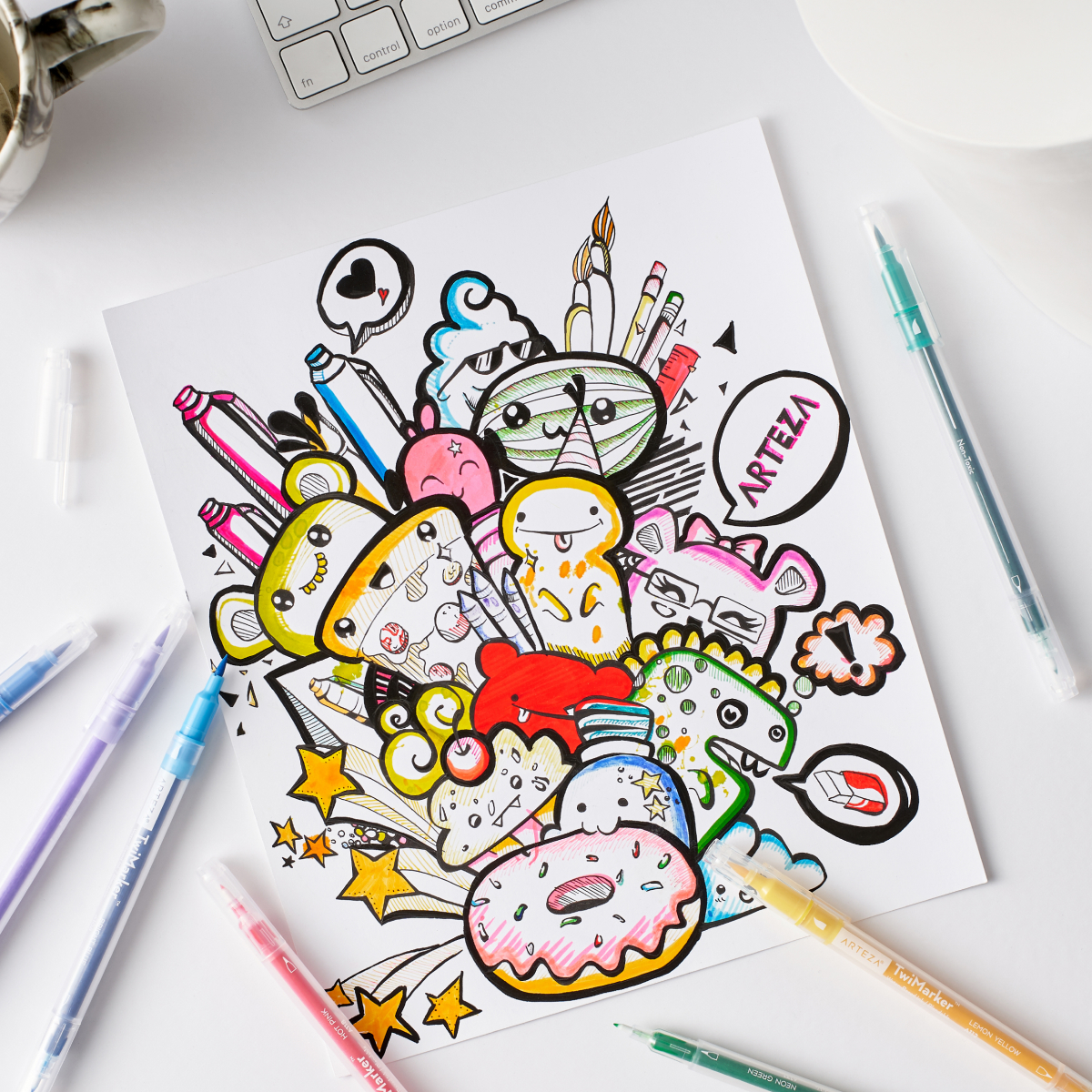Table of Contents:
How to Become More Creative
Creativity is the car driving you on artistic adventures. It is the mechanism by which your idea is turned into something substantial. To make sure your automobile runs, you keep it tuned up, well-oiled, and in tip-top condition. If you didn’t, you might be stranded somewhere wondering what to do next. Your creativity is no different. If you don’t keep an eye on your creative thinking skills, you’ll be staring into space, scratching your head and trying to figure out why your mind is as blank as the canvas.
Just as an automobile needs gas to keep it running, your mind needs experiences and challenges to develop ideas. The more of these you throw at it, the more answers it has and the ideas begin to flow. So, what are examples of creativity exercises and how do they work?
Creative thinking exercises offer your brain motivation and a chance to think up those ideas. In fact, some of the country’s largest corporations, such as Google, Apple, and Microsoft, encourage their employees to stretch the boundaries of ideation to come up with new products every year. They encourage creative play, group brainstorming, and collaboration. To help you get the wheels turning, we’ve got seven exercises for you to try. Before you know it, you’ll have so many ideas you won’t know which to do first!
Rev-Up Your Creative Thinking Skills

Exercise 1: List Creative Uses for an Everyday Object
In this exercise, you’ll choose any humdrum object, such as a rock or a safety pin, and jot down at least 10 uses for it. Don’t limit yourself to the actual uses; think of any way it could be used or transformed into something else. Don’t stop until you have at least 10 things on the list. Who knows, you may discover that a painted rock really does make an excellent doorstop. Just try it out!

Exercise 2: Pick a Place
You can use a printed map or Google’s map of the world for this. Close your eyes and let your finger linger over the map until you place it on the map. Open your eyes and see your location. Now imagine you’re there scouting out ideas for your next artwork. Think about how that place could translate into your art. Are there historical landmarks to paint or sketch? Does it have awesome beaches or spectacular skylines that could be a good subject for your next drawing? Maybe you could create a mini travel brochure about this place. The colors of this area could evoke images of your next great abstract work.

Exercise 3: Sticky Note Brainstorming
Give yourself an assignment, such as designing a new art tool. Now take a pad of sticky notes and quickly write anything you can think of to help you in your design. You might write things like, “it has to be sharp,” “made of steel,” “it comes in 11 colors,” “it can double as a fork;” whatever comes to mind about your new gadget. As you write, stick the notes to the wall until you’ve used most of the pad. After you’re finished, read all the notes and see if you can draw the object you’ve created. Make it as outlandish or practical as you like!

Exercise 4: Take Your Inner Artist on a Date
In Julia Cameron’s book, “The Artist’s Way,” she suggests having weekly dates with your inner artist. She suggests going out and exploring the world through the eyes of an artist. While you’re taking a walk in your neighborhood, strolling through a museum, drinking coffee at a nearby shop, or sitting on a bench in the park, notice the elements of your environment.
By taking time away from your normal routine and work, you’re giving your inner artist permission to soak in all the colors, sights, and smells that you usually rush by. Use a small notebook and either sketch or write some of the things you see. Once you get home, read over your notes and make a list of what you can turn into projects. Tear out the list and pin it over your desk for future works.

Exercise 5: Give Yourself a Challenge with Accountability
We’re sure you’ve seen artist challenges on social media. Whether you’re trying to draw 100 faces in 100 days or complete 30 paintings in 30 days, challenges with a deadline and accountability will not only boost your creativity but will increase your skills. Start with something that you know you can do and give it a push. If you know you can draw cats, can you draw a cat a day for 20 days?
As you create your cats, make it part of the challenge that you have to post your drawing every day on social media with the hashtag #CatADay. Posting helps keep you accountable.
As you draw your cats, you’ll soon start having tons of ideas about how to change them up a bit. You may discover you love to draw them using markers instead of pens or pencils, or that blue cats are your thing. Let the challenge inspire you!

Exercise 6: Use Geometric Shapes
This is another good exercise using sticky notes. Remove 25 notes and stick them on the wall. Now, draw either a square, a circle, or a triangle on each note (make sure all the notes have the same shape). Go back to the first one and use that shape to draw what it is. For example, if you have a square, use it as the bread and draw a sandwich. Do this on every one. Step back and see what you’ve done. Is there one that jumps out at you? This may be the inkling for a new project.

Exercise 7: Play the “What If” Game
Start by writing down a noun (a person, place, or thing). Then by using ‘What If” questions, list all the possibilities of what you’ve written. For instance, the first word could be “horse.” You could ask yourself, “What if the horse was blue?” Now write “blue horse.” Ask again, “What if that blue horse had wings?” Write “blue horse with wings.” “What if that blue horse with wings could talk?” Write “talking blue horse with wings.”
You get the picture, right? Keep going until you’ve asked the “What If” question at least a dozen times. By the end, you should have a pretty interesting object that could turn into your next graphic novel superhero or the next subject for a painting.

Exercise 8: Schedule Day Dreaming
The best ideas often come when we’re doing mindless activities, such as showering or folding the laundry. That’s why an important activity you can do to nurture your creative side is to give your thoughts time to roam freely. When you do this consistently, you’ll discover your mind is full of ideas just waiting to be activated. To do this, you can schedule some daydreaming sessions.
Choose a time, put it on your calendar, and stick to it. When that time comes, take a deep breath and step away from your work. It helps to go outside and look up at the sky, but if that’s not possible, put on your headphones and just let your mind wander. Try to keep your mind on pleasant things, staying away from work-related tasks or personal problems. Once you come back to your regular routine, you’ll feel more refreshed and creative.
Wrap Up
There you go! Eight exercises that are as fun to do as they are productive. If you do these regularly, you’ll soon develop them as habits of the creative mind. Next time you’re stalled for what to make next, give one of these creative thinking examples a try and get your creative motor running again.
We’d love to hear what you do when you’re stuck. Tell us how in the comments section below!
















